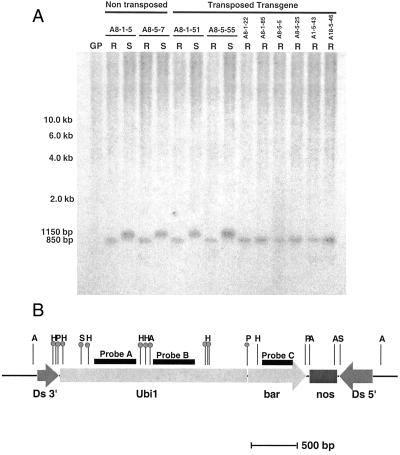Figure 4.
A, Methylation analysis of Basta-sensitive and Basta-resistant plants from lines with transposed and non-transposed Ds-bar cassette. DNA blots of HpaII-digested genomic DNA from Basta-sensitive and Basta-resistant plants were hybridized with probe A (B) from the 5′ end of the ubiquitin promoter of the Ds-bar cassette. Lanes containing DNA from Basta-resistant plants have an 850-bp hybridization fragment, as expected for a non-methylated HpaII site in the ubiquitin promoter region. Digests of DNA from Basta-sensitive plants have fragments of 1,150 bp, indicating methylation of an HpaII site in the immediate 5′ region of probe A (B). R, Basta-resistant; S, Basta-sensitive; GP, Golden Promise non-transgenic control. B, Methylation analysis of promoter and coding region of Ds-bar cassette in Basta-sensitive lines. Diagram summarizes results of digests with different methylation-sensitive enzymes (A, AvaI; H, HpaII/MspI; P, PstI; Sc, SacII; and S1, SalI) and hybridization with three different probes (A, B, and C). HpaII/MspI sites are numbered I through VII from left to right. A total of 20 different Basta-sensitive plants from eight different lines were analyzed. Based on the size of hybridization fragments and information regarding the restriction sites in the Ds-bar cassette, the position of specific methylated sites was determined. In some cases different HpaII/MspI sites are not sufficiently separated to allow differentiation between individual sites. In accordance with this, closely connected sites were marked as methylated if at least one of the sites was methylated. A circle on top of the lines symbolizes methylation was detected at that site in at least some plants. Size bar indicates 500 bp.

